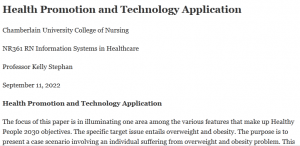Health Promotion and Technology Application

Chamberlain University College of Nursing
NR361 RN Information Systems in Healthcare
Professor Kelly Stephan
September 11, 2022
Health Promotion and Technology Application
The focus of this paper is in illuminating one area among the various features that make up Healthy People 2030 objectives. The specific target issue entails overweight and obesity. The purpose is to present a case scenario involving an individual suffering from overweight and obesity problem. This condition is one of the most common health problems that affect individuals across the United States. Within the last four decades, the rate of obesity has just about tripled. More than a third of adults in US have obesity. More than 40% of adults in the country are obese while about 37% are considered overweight (CDC, 2022). As of 2016, about 2 billion adults were overweight. The paper covers the plan of education for individuals facing this health issue and the utilization of technology application in helping address the concerns. The essence is in presenting the significance of technological applications in helping alleviate the health conditions and behaviors the Healthy People 2030 milestones.
Patient Scenario
The Healthy People 2030 topic of choice is overweight and obesity. This condition refers to the situation whereby the accumulation of abnormal or excessive fat leads to the impairment of health (Chu et al., 2018). The body weight at this point is greater than normal or what is healthy for a certain heart. Body mass index (BMI) is a tool that is utilized in classification of overweight and obesity levels in adults. BMI equal to or greater than 25 is considered as overweight and it reaches obesity when the figure rises up to 30 and above (Chu et al., 2018). Being overweight could also be due to extra muscle, water or bone.
The patient under focus is a 37 year old male. He is five feet and 10 inches tall and weighs 200 pounds. He has had a problem controlling his weight and keeping it under the suitable level for most of his adult life. His family has a history of weight problems as his father and three uncles had similar issues at some point in the span of their lives. He spends most of his time working which is generally in seated position and the rest of the time he seats with his family. The patient rarely exercises, take walks or watches his diet. The BMI of the patient is 28.70 . The learning needs are established around the consequences of being overweight and strategies for mitigating the weight problem. These areas of learning needs form the core aspects that have relevance to the problem. The key parts of in assessing readiness to learn will entail examination of capacity of the patient to process essential health information and their previous experience and knowledge about the health topic. These parts are integral in determining the background of the health concern, and the capacity of the patient to comprehend and follow the appropriate measures.
Patient Education/Teaching Plan
. The first step after assessment of learning needs is for the patient to understand the significance of the problem to develop the objectives of learning. It is imperative the patient has full perspective about what his current weight status means (Yen & Leasure, 2019). From the case, the patient is overweight thus the main concerns are obesity and subsequently diabetes, heart disease and heat attacks which are more or less fatal. The plan should involve pinpointing the goals of health promotion and how to achieve them (Yen & Leasure, 2019). The utilization of technology should feature in the achievement of the goals. Emphasis should be more on changing lifestyle for health improvement and attainment of the right balance of calories and energy and also diet changes. Both are proven to be effective in addressing weight problems and can be applied for more impactful outcomes (Yen & Leasure, 2019). The patient education should cover provision of material in different formats like brochures and online teaching to enable the learning process. Additional step may be following up on the impact of the patient education through assessment of their understanding and willingness to follow the right measures.
mHealth app: MyFitnesPal
MyFitnessPal is a technology that functions over the website and as an application. Its core purpose is to track exercising and diets (MyFtnessPal, 2022). The main audience that it serves are people who are on weight management thus it is suitable for the patient. Any smartphone operating on Android and iOS operating systems can help in utilizing the technology. The application tracks the nutrients of the users through scanning barcodes of different food items or alternatively access the details through the database within the app. It provides the benefit of harmonizing the fitness information from other apps like FitBit, Apple Watch and Samsung Health into one platform (MyFtnessPal, 2022). The app can be accessed on its main website ( https://www.myfitnesspal.com) or by downloading it on Play Store.